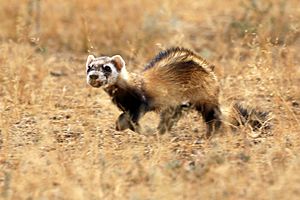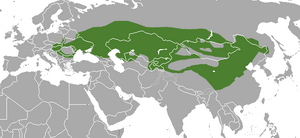Steppe polecat facts for kids
Quick facts for kids Steppe polecat |
|
|---|---|
 |
|
| at the Stepnoi Sanctuary | |
| Conservation status | |
| Scientific classification | |
| Genus: |
Mustela
|
| Species: |
eversmanii
|
 |
|
| Steppe polecat range | |
The steppe polecat (Mustela eversmanii) is a type of mustelid. It is also known as the white or masked polecat. These animals live in Central Europe, Eastern Europe, and Central Asia. The steppe polecat is considered a Least Concern species, which means it is not currently in danger of disappearing. It usually has light yellowish fur, dark legs, and a dark mask-like pattern across its face.
Contents
About the Steppe Polecat
Steppe polecats are medium-sized mustelids. Male polecats are usually 320 to 562 millimeters (about 12.6 to 22.1 inches) long. They can weigh up to 2,050 grams (about 4.5 pounds). Females are a bit smaller, measuring 290 to 520 millimeters (about 11.4 to 20.5 inches) long. They weigh up to 1,350 grams (about 3 pounds).
Their fur changes with the seasons. In winter, their fur is soft and thick. It has a short, dense layer underneath and longer, sparser guard hairs on top. In summer, their coat is shorter and rougher. It is also less dense and can look more yellowish or reddish. Their ears are completely white, and their throat is yellowish-white or almost white. Sometimes, their whole head can be white. The lower part of their neck is dark blackish-brown or brown. Their chest and front legs are black or blackish-brown, while their belly is light yellowish-straw in color.
Behavior and Habits
Steppe polecats often stay in one area for a few days or even a few months. This is especially true in warm seasons when there are many ground squirrels to hunt. Older polecats usually do not leave their territory until there is no more food left.
In winter, steppe polecats become more active. They might travel 12 to 18 kilometers (about 7.5 to 11 miles) in a single day. If there is a lot of heavy snow, they will move to better places. These places might be along the sides of steppe ravines, near human settlements, or winter camps.
These animals usually do not dig their own burrows. Instead, they use burrows made by other animals like marmots, ground squirrels, hamsters, moles, voles, and jerboas. They just make the burrow a little wider to fit.
Reproduction and Life Cycle
The mating season for steppe polecats can be different depending on where they live. They usually mate once a year. The pregnancy period lasts from 36 to 43 days. A female steppe polecat typically gives birth to three to six babies, called kits. However, some have been known to have as many as 18 kits!
When kits are born, they are blind and have no fur. After about 20 days, their fur starts to grow and darken. Their eyes open when they are 28 to 34 days old. By the time they are 45 days old, they can start hunting young ground squirrels. They learn to hunt adult ground squirrels when they are about 60 days old.
The kits stay with their family in the burrow for about two to two and a half months. They begin to leave the family in July or later. Steppe polecats become old enough to have their own babies at about 10 months old. They are considered full-grown adults when they are two years old.
What Steppe Polecats Eat
The steppe polecat mainly hunts large mammals that live in the steppe grasslands. Their favorite foods include ground squirrels, hamsters, pikas, and young or injured adult marmots. Ground squirrels are the most common food for steppe polecats all year round.
In warm seasons, they hunt ground squirrels above ground. In autumn, they dig them out of their burrows. Male polecats often have to make the ground squirrel burrows wider to get inside. However, young or female polecats can usually fit easily.
In areas where there are no ground squirrels, steppe polecats mostly eat hamsters and pikas. If they live near water, they might eat water voles. Along the shores of rivers and lakes, they might eat fish, chickens, or even carrion (dead animals). Sometimes, they will hunt birds. They rarely eat amphibians (like frogs) or reptiles (like lizards).
Where They Live
The steppe polecat lives across a wide area. You can find them in Central and Eastern Europe, southern Russia, northern Georgia, Kazakhstan, Turkmenistan, Uzbekistan, Tajikistan, and Kyrgyzstan. Their range extends all the way to Mongolia and northern and western China. In 2014, a steppe polecat was even seen very high up in the mountains of Nepal, at an altitude of 5,050 meters (about 16,570 feet)!
Images for kids
-
Skull and teeth, as illustrated in Pocock's The Fauna of British India, including Ceylon and Burma - Mammalia Vol 2
See also
 In Spanish: Turón de la estepa para niños
In Spanish: Turón de la estepa para niños





